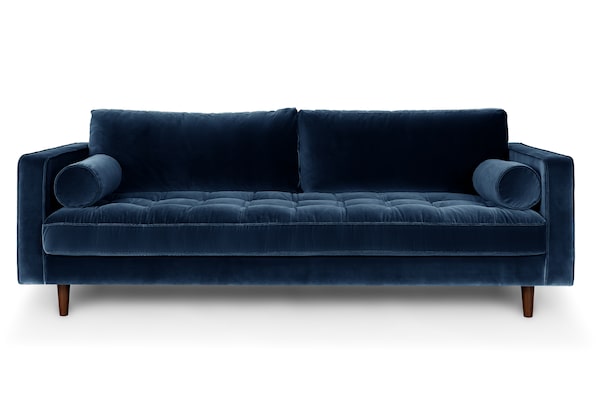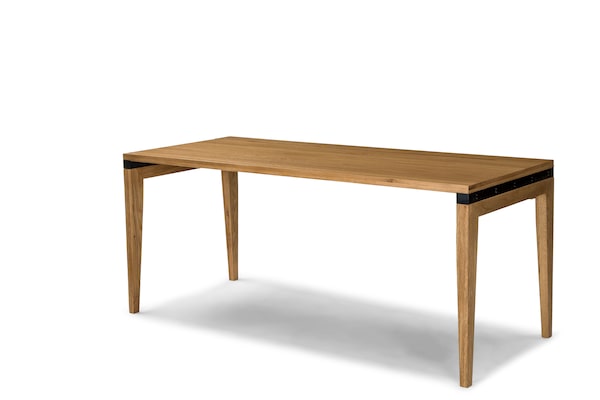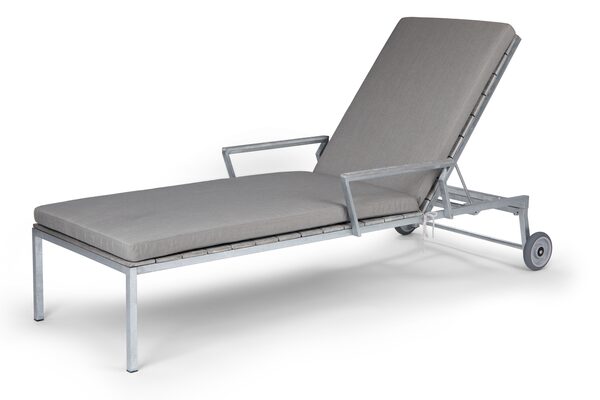Last year, Amanda Durepos realized it was time to make an important change. She was living in a city she loved, Montreal, had a job she loved as a marketing professional, and had a nice place in a classic Montreal triplex, the kind with a wrought-iron stoop that twists up from the street. But, after reaching her late-20s, she knew it was no longer okay to be using an old, threadbare sofa. “It was quite gross,” she says. “It was handed down from friends, who had it handed down to them from other friends.”
Durepos’s replacement piece, which she describes as her “first, real adult furniture,” is a significant step up. Midnight-blue with mid-century-modern lines and upholstered in a plush, tufted velvet, the couch is over seven feet long, so can comfortably seat several of her friends, and is immaculate.

Midnight-blue with mid-century-modern lines and upholstered in a plush, tufted velvet, the couch is over seven feet long, so can comfortably seat several of her friends, and is immaculate.
And although the price, at just over $1,500, wasn’t cheap – “I saved for it,” she says. “It took six months before I finally took the plunge” – for the same construction and durability, it could have easily cost $2,500 or more at a traditional bricks-and-mortar retailer.
Instead, Durepos made the purchase sight unseen from a Vancouver-based online retailer called Article, which shipped it flat-packed for her to put together herself. This some-assembly-required approach, popularized over the last half-century by Swedish manufacturer IKEA, was once exclusively synonymous with mass-produced, relatively flimsy goods. But now, even high-design, top-quality furniture makers, many of which only sell online, are adopting the model for its numerous benefits.
Flat-packing tends to be the cheapest, easiest and fastest way to ship something, which therefore reduces the price of the furniture – even when it’s made from expensive materials. And furniture that can be easily assembled, disassembled and moved multiple times is critical for a generation of globe-trotting nomads. Lastly, when the furniture is a kit of parts, if one piece gets damaged, the whole thing doesn’t become waste – making it more sustainable.
According to Lauren Kase, head of marketing for Detroit-based furniture business Floyd, “there is a broken model of frustration around furniture,” she says. “You basically have two options. Drive out to somewhere suburbanesque and Tetris your car up with things that are cheap and not built to last. Or buy something high-end design that takes 14 weeks and is super-expensive.”

IKEA’s some-assembly-required model to furniture production and sale has been adopted by numerous high-design, top-quality furniture makers.
Floyd offers a different solution. Its minimal, industrial-style furniture, most of which costs less than US$1,000, is made from hearty materials – Baltic birch, linoleum, painted steel – for long-term durability. It’s all sold online, can be delivered in as little as four to seven hours in major U.S. centres, such as New York and San Francisco, and is engineered to be assembled, disassembled and moved multiple times without breaking down. The Floyd table, for example, looks like weighty wood but has a hollowed-out top so that it’s light to carry around.
“I think the whole landscape has changed so much,” says Kase. “More young people are living in cities, moving more frequently, and need the convenience of fast deliveries and easy assembly and disassembly. But a lot of people are also moving away from a culture of disposability. It’s amazing for people to have long-lasting pieces – to be able to say, here is my grandmother’s design.”
Floyd is only one of a dozen or so companies that have opened in the past five years offering high-end, flat-packed furniture. The incentive for such businesses is clear. In Canada alone, the overall furniture market was $11.4-billion in 2017, which represents a strong 8.6-per-cent growth from three years earlier, according to federal statistics. Sales are dominated by flat-pack giants – IKEA sells 19 per cent of Canada’s furniture, and Leon’s Furniture Ltd. (which owns Leon’s and the Brick) sells close to 23 per cent – but any company that can offer a similar convenient product, perhaps at a higher quality, stands to gain as the market continues growing, even if the prices are higher.

Vancouver-based Article was founded in 2013 by four software engineers who wanted to streamline the often cumbersome process of picking, purchasing and waiting for new, high-end furniture.Courtesy of Article
Vancouver-based Article, where Durepos bought her couch, was founded in 2013 by four software engineers who wanted to streamline the often cumbersome process of picking, purchasing and waiting for new, high-end furniture. Everything is made with durable materials (oak, marble) and arrives a few weeks after ordering.
So far, the company’s success has been staggering. After only three years in business, it reached $100-million in sales. This year, the company is projected to double that volume to $200-million.
Part of the winning formula is that the furniture is well-considered, not just aesthetically, but in terms of the at-home, DIY construction process. “We are always testing assembly of our products in our office,” says Maureen Welton, Article’s vice-president of creative and design.
Durepos’s sofa was easy to put together. “A friend offered to help, but I put it together myself,” she says. “It came with Ikea-like diagrams and took less than 15 minutes.”
Creating highly durable, easy-to-assemble pieces also interests San Francisco-based designer Ros Broughton. His family has been manufacturing furniture for four generations.
But while his forebears used to make heirloom-worthy, solid-wood pieces – the kind that came preassembled and couldn’t be broken apart without destroying them – the proliferation of globalized, cheap yet disposable goods in his lifetime rendered that obsolete. Or maybe not.
At his company, Fyrn, he maintains his family tradition of working with the best hardwoods – oak, walnut – often by hand. But he’s also created a proprietary, highly standardized, kit-of-parts system called Stemn, which consists of sleek anodized aluminum fasteners that make for easy at-home assembly and disassembly (not to mention an unusual aesthetic – the mix of metal and wood looks like Shaker craftsmanship updated with a Robocop twist).

“We are always testing assembly of our products in our office,” says Maureen Welton, Article’s vice-president of creative and design.Courtesy of Article
The pieces are built to last – to date, most of the customers have been restaurants and bars, which tend to be hard on furniture. “The hardware is exquisite,” notes restaurateur Margherita Sagan, who has used Fyrn chairs in two establishments, San Francisco’s Noon All Day and Piccino. “And the chairs themselves are the most comfortable and customizable I have ever come across.”
But the modularity is also practical: If one piece breaks you don’t have to throw the chair out, you can simply order a replacement part.
Fyrn’s pieces and parts can be expensive. One stool, the Stanyan, costs US$615 each. David Charne, Fyrn’s co-founder and business manager, would like to scale the manufacturing process so that the price can come down. “I hope that, eventually, middle-class homes will have these pieces,” he says. “Especially because they don’t have the same hidden costs, in terms of workers’ rights and environmental damage.” (Fyrn manufacturers everything in San Francisco.)
For Durepos, the higher price of her sofa wasn’t an issue in the end. She would “100-per cent” buy more high-end, flat-packed furniture, she says. Instead, the problem is that upgrading her couch had the “unintended effect of making everything else in my place look bad in comparison,” she says. “My IKEA coffee table, for example. I think it’s going to be hitting the curb soon.”
Special to The Globe and Mail